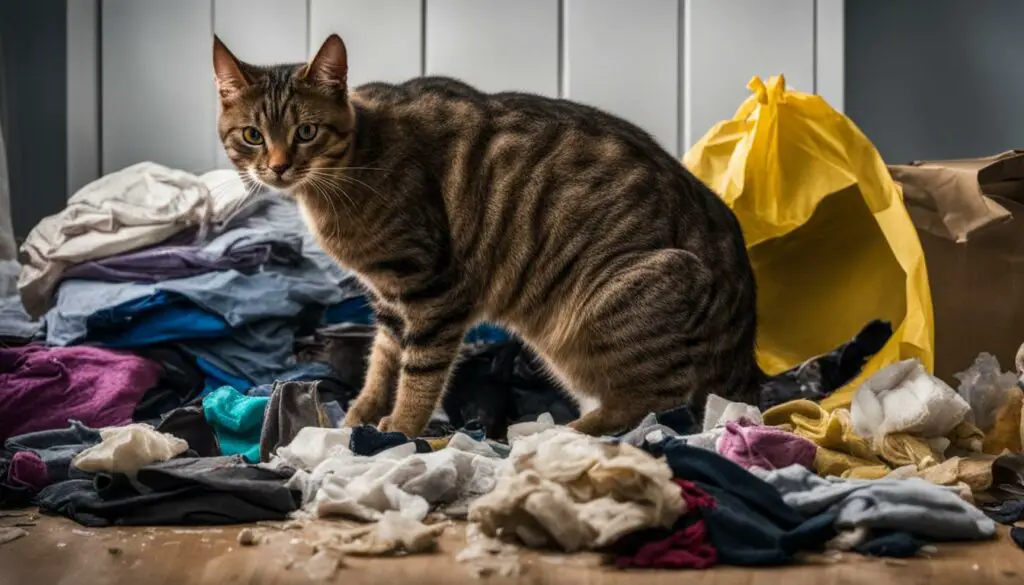Inappropriate urination is a common concern for pet parents, with many cats choosing to pee on bags and clothes on the floor instead of using their litter boxes. This behavior can be frustrating and puzzling, but there are underlying causes that can help us understand why our cats exhibit this behavior.
There are a few possible reasons why your cat may be peeing on bags and clothes. It could be due to medical conditions such as urinary tract infections, kidney disease, or diabetes. On the other hand, it could be a behavioral issue caused by stress, anxiety, or territorial marking. Another possibility is that there might be problems with the litter box itself, such as its location, type, size, or cleanliness.
Understanding the reasons behind your cat’s inappropriate urination behavior is the key to finding solutions and preventing future accidents. In this article, we will explore the medical and behavioral causes of this behavior, discuss tips for litter box training, and provide advice on how to maintain a healthy relationship with your feline companion.
Key Takeaways:
- There can be medical and behavioral causes for inappropriate urination in cats.
- Medical conditions like urinary tract infections, kidney disease, and diabetes can contribute to this behavior.
- Stress, anxiety, and territorial marking can also lead to cats peeing on bags and clothes.
- Litter box issues, including location, type, size, and cleanliness, can be a factor in this behavior.
- Proper litter box training, understanding your cat’s needs, and seeking professional help when needed can help address this issue.
Medical Causes of Inappropriate Urination
In some cases, a cat may choose to urinate outside of their litter box due to various medical conditions. These conditions can cause discomfort and an increase in urination frequency, leading to inappropriate urination behavior. It is important for pet owners to be aware of these medical causes and seek proper diagnosis and treatment in order to address the issue effectively.
Urinary Tract Infection (UTI): UTIs are a common medical cause of inappropriate urination in cats. These infections can cause pain and inflammation in the urinary tract, leading to a cat’s aversion to using the litter box.
Feline Lower Urinary Tract Disease (FLUTD): FLUTD is a collective term that encompasses a range of conditions affecting the lower urinary tract in cats. These conditions can cause discomfort, pain, and difficulty urinating, leading to inappropriate urination behavior.
| Medical Causes | Key Points |
|---|---|
| Urinary Tract Infection (UTI) | Common cause of inappropriate urination |
| Feline Lower Urinary Tract Disease (FLUTD) | Encompasses various conditions affecting the lower urinary tract |
| Kidney Disease | Can cause increased urination frequency and discomfort |
| Diabetes | Can result in increased thirst and urination |
| Endocrinopathies | Hormonal imbalances that can affect urination |
Kidney Disease: Kidney disease can affect a cat’s ability to filter waste products from their blood, leading to increased urination frequency and discomfort. This can result in inappropriate urination behavior.
Diabetes: Diabetes is a metabolic disorder that can cause increased thirst and urination in cats. If left untreated, diabetes can contribute to inappropriate urination behavior.
Endocrinopathies:Endocrinopathies refer to hormonal imbalances that can affect a cat’s urinary habits. These imbalances can lead to changes in urination frequency and behavior, resulting in inappropriate urination.
Behavioral Causes of Inappropriate Urination
When it comes to cats peeing on bags and clothes on the floor, behavioral issues can often be the culprit. Stress, anxiety, and territorial marking are some common behavioral causes that can contribute to this behavior. Cats may feel stressed or anxious due to changes in their environment, such as the introduction of new pets or new babies in the household. These changes can disrupt their routine and lead to inappropriate urination.
Territorial marking is another behavioral cause that can result in cats peeing on items like bags and clothes. Cats use urine marking as a way to establish their territory and communicate with other cats. This behavior can be triggered by the presence of outdoor cats or other cats in the neighborhood.
To address these behavioral causes, it’s important to create a calm and stress-free environment for your cat. Provide them with a designated space where they feel safe and secure. You can also consider using pheromone diffusers or sprays, which can help reduce stress and anxiety in cats. Additionally, providing plenty of playtime and mental stimulation can help alleviate boredom and redirect any negative behaviors.
Litter Box Issues
When it comes to addressing inappropriate urination, it’s important to consider the role that the litter box plays in your cat’s behavior. Cats can be quite particular about their litter box preferences, and any issues with the litter box itself can contribute to their decision to urinate elsewhere.
The Importance of Litter Box Location
The location of the litter box is a key factor in encouraging your cat to use it consistently. Cats prefer a quiet and private area where they can feel safe while using their litter box. Placing it in a high-traffic area or near loud appliances can be stressful for your cat and may deter them from using it.
Choosing the Right Type and Size
Not all litter boxes are created equal, and finding the right type and size for your cat is crucial. Some cats prefer open litter boxes, while others prefer ones with a hood or cover for added privacy. It’s also important to consider the size of the litter box – it should be large enough for your cat to comfortably turn around in and dig around without feeling cramped.
| Type | Advantages | Disadvantages |
|---|---|---|
| Open Litter Box | Easy access for cats, no odors trapped | Litter may be easily kicked out, less privacy |
| Covered Litter Box | More privacy, reduces odor | May be too confined for larger cats, may trap odors if not cleaned regularly |
| Self-Cleaning Litter Box | Automatically removes waste, less scooping | Maintenance and noise, may startle some cats |
Maintaining Cleanliness
A clean litter box is essential to encourage your cat to use it regularly. Cats are naturally clean animals and may avoid a litter box that is dirty or smells unpleasant. Scooping the litter box daily and completely changing the litter on a regular basis will help keep it fresh and inviting for your cat.
By addressing these litter box issues, you can create an environment that is more conducive to your cat using their litter box consistently. Remember to consider your cat’s preferences when it comes to location, type, and cleanliness in order to prevent inappropriate urination and maintain a happy and healthy feline companion.
Tips for Litter Box Training
Training your cat to use the litter box consistently is essential for preventing inappropriate urination. Each cat may have their own preferences and habits when it comes to the litter box, so it may require some trial and error to find the right setup that works for your feline friend. Here are some tips to help you with litter box training:
- Understand your cat’s preferences: Cats have individual preferences when it comes to litter box habits. Some may prefer a certain type of litter, such as clumping or non-clumping, while others may prefer a specific texture or scent. Experiment with different options to find what your cat likes best.
- Maintain consistency: Once you have found the litter and litter box setup that your cat prefers, try to maintain consistency. Cats are creatures of habit and appreciate stability in their environment. Avoid frequent changes to the litter or litter box location, as this can confuse your cat and lead to accidents.
- Ensure accessibility: Make sure the litter box is easily accessible to your cat. It should be placed in a quiet and private location where they feel comfortable. Avoid placing the litter box near loud appliances or in high-traffic areas, as this could discourage your cat from using it.
- Prioritize privacy: Cats value their privacy when using the litter box. Consider using a covered litter box or placing it in a secluded area to provide your cat with the privacy they desire. Some cats may feel vulnerable while using the litter box, so creating a safe and secure environment can encourage them to use it consistently.
Remember, litter box training requires patience and understanding. It may take some time for your cat to adjust to the litter box and develop consistent habits. Be consistent with your training efforts, provide positive reinforcement when your cat uses the litter box correctly, and avoid punishment for accidents. With time and the right approach, you can successfully train your cat to use the litter box and prevent inappropriate urination behavior.
Table: Common Litter Box Training Challenges and Solutions
| Challenge | Solution |
|---|---|
| Cat avoids using the litter box | Ensure cleanliness, try a different type of litter, or consult a veterinarian for any underlying medical issues. |
| Cat only uses a specific spot in the house | Place a litter box in that area or gradually move the litter box to a more suitable location. |
| Cat eliminates outside the litter box after a change in the household | Introduce changes gradually to minimize stress and provide extra litter boxes in different locations. |
| Cat kicks litter out of the box | Try a litter box with higher sides or a covered litter box to contain the litter. |
By following these tips and troubleshooting any challenges that arise, you can effectively train your cat to consistently use the litter box and prevent them from peeing on bags and clothes on the floor.
Identifying the Underlying Cause
When dealing with a cat that pees on bags and clothes on the floor, it is crucial to identify the underlying cause of this behavior. This begins with a thorough examination of the cat’s medical history and a physical exam by a veterinarian. Tests such as a urinalysis and blood tests can help rule out or diagnose medical problems that may be contributing to the behavior.
If medical issues are ruled out, it is essential to consider any potential behavioral causes. Stress, aggression, and changes in the environment can all contribute to inappropriate urination behavior. A behavioral assessment may be necessary to identify any underlying stressors or changes that could be triggering the behavior.
Identifying the underlying cause is crucial for finding effective solutions. By addressing both medical and behavioral causes, pet owners can take the necessary steps to resolve the issue and prevent future incidents. It is important to approach this process with patience and seek professional advice if needed.
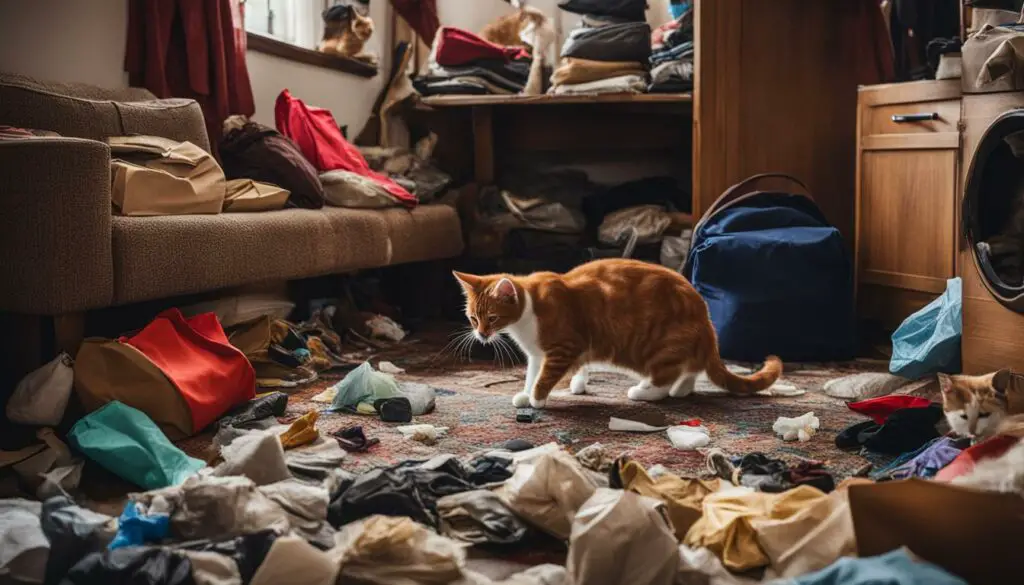
Key Factors to Consider
- Stress: Changes in the household environment can cause stress in cats, leading to inappropriate urination behavior. Identifying and addressing these stressors can help resolve the issue.
- Aggression: Aggressive behavior between cats or towards humans can contribute to inappropriate urination. It is crucial to assess any potential aggression and take appropriate measures to address it.
- Medical Problems: In some cases, underlying medical conditions such as urinary tract infections or kidney disease can cause inappropriate urination behavior. A thorough medical examination is essential to rule out any medical issues.
- Behavioral Issues: Changes in the environment or disruptions in the cat’s routine can trigger inappropriate urination. Understanding and addressing these behavioral issues can help resolve the problem.
By considering these factors and working closely with a veterinarian or a veterinary behaviorist, pet owners can identify and address the underlying cause of inappropriate urination in their cats.
| Cause | Symptoms |
|---|---|
| Medical Problems | – Frequent urination – Blood in the urine – Straining to urinate |
| Stress | – Changes in behavior – Excessive grooming – Hiding or avoiding certain areas |
| Aggression | – Growling or hissing – Swatting or biting – Piloerection (hair standing on end) |
| Behavioral Issues | – Marking territory – Urinating outside of the litter box – Changes in appetite or activity level |
Preventive Strategies
In order to prevent future incidents of inappropriate urination, it is important to implement various preventive strategies. These strategies can help address the underlying causes and minimize the chances of your cat peeing on bags and clothes on the floor. Here are some key preventive measures to consider:
Litter Box Management
One of the most important aspects of preventing inappropriate urination is proper litter box management. Ensure that you provide enough litter boxes for your cat, following the general rule of one litter box per cat, plus one extra. Place the litter boxes in different locations throughout the house to provide easy access for your cat. Keep the litter boxes clean by scooping waste daily and changing the litter regularly. Cats are often sensitive to the cleanliness of their litter boxes, so maintaining a clean environment is crucial in preventing accidents.
Stress Reduction
Stress can be a major contributing factor to inappropriate urination behavior in cats. Create a calm and stress-free environment for your cat by providing them with a designated space where they can retreat and relax. Use pheromone diffusers, such as Feliway, to help reduce anxiety and create a sense of security. Engage in regular playtime and provide environmental enrichment to keep your cat mentally stimulated and alleviate stress. Minimizing changes in the household and maintaining a consistent routine can also help reduce stress levels.
Behavioral Modification
If your cat continues to exhibit inappropriate urination behavior despite other preventive measures, behavioral modification techniques may be necessary. Consult with a professional cat behaviorist for personalized guidance and advice. They can help you identify and address any underlying behavioral issues that may be contributing to the problem. Behavioral modification techniques may include positive reinforcement, desensitization, and counterconditioning exercises to modify your cat’s urination behavior.
| Preventive Strategies | Benefits |
|---|---|
| Litter Box Management | Ensures easy access and cleanliness, reducing the likelihood of inappropriate urination |
| Stress Reduction | Creates a calm environment and minimizes anxiety, which can contribute to inappropriate urination |
| Behavioral Modification | Addresses underlying behavioral issues and helps modify your cat’s urination behavior |
By implementing these preventive strategies, you can significantly reduce the chances of your cat peeing on bags and clothes on the floor. However, it’s important to remember that each cat is unique, and it may take some time and experimentation to find the right combination of strategies that work for your cat. Patience, consistency, and love are key in resolving inappropriate urination behavior and maintaining a healthy relationship with your feline companion.
Seeking Professional Help
While addressing the underlying causes of inappropriate urination can often be done with simple changes and training, there are instances where seeking professional help becomes necessary. A veterinary behaviorist is a specialized professional who can assist in developing a personalized treatment plan for your cat. They have the knowledge and experience to diagnose and address complex behavioral issues that may be contributing to the problem.
When consulting a veterinary behaviorist, they will conduct a thorough examination of your cat’s medical history and may perform additional tests to rule out any underlying medical conditions. Based on their findings, they will recommend behavior modification techniques, medication, or a combination of both to address the root cause of the inappropriate urination behavior.
It’s important to remember that seeking professional help is not a sign of failure as a pet owner. Veterinary behaviorists are equipped with the expertise needed to provide the best possible care and solutions for your cat. Their guidance will help you navigate any challenges and ensure a positive outcome for both you and your furry companion.

Benefits of Seeking Professional Help
There are several benefits to seeking professional help for your cat’s inappropriate urination behavior:
- Expertise: Veterinary behaviorists are trained professionals who specialize in understanding and addressing complex behavioral issues in cats.
- Accurate Diagnosis: They can conduct comprehensive evaluations to determine the underlying cause of the behavior, whether it’s medical or behavioral.
- Personalized Treatment Plan: Based on their assessment, they can develop a customized treatment plan tailored to your cat’s specific needs, taking into account their medical history, environment, and individual behavior patterns.
- Behavior Modification Techniques: Veterinary behaviorists can teach you effective behavior modification techniques to address the underlying cause of the inappropriate urination behavior and help your cat learn new, more appropriate habits.
- Support and Guidance: They provide ongoing support and guidance throughout the treatment process, ensuring that you have the resources and knowledge to successfully implement the recommended strategies.
By seeking professional help, you can increase the likelihood of resolving your cat’s inappropriate urination behavior and create a harmonious living environment for both you and your feline companion.
Understanding Your Cat’s Language
Cats have a unique way of communicating, and their urination behavior can convey important messages. When a cat chooses to pee on bags and clothes on the floor instead of using the litter box, it may be trying to communicate something to its owner. One possible explanation for this behavior is scent marking, where a cat uses urine to leave its personal scent and assert its territory. By marking items like bags and clothes, cats are claiming ownership and sending a message to other animals or even humans.
Another reason for this behavior could be territorial behavior. Cats are naturally territorial creatures, and they may mark their territory by urinating on objects that they perceive as intrusions. The presence of a new pet, changes in the household, or the introduction of unfamiliar objects can trigger this territorial response. Understanding the reasons behind your cat’s urination behavior can help you address the underlying issue more effectively.
Cats are masters of non-verbal communication. When they urinate outside the litter box, they are attempting to communicate something to their owners.”
It’s important to note that inappropriate urination can also be a response to stress or anxiety. Cats are sensitive animals, and changes in their environment can cause them to feel uneasy. Whether it’s a move to a new home, the addition of a new family member, or other disruptions, these changes can trigger urination outside the litter box as a result of heightened stress levels. Understanding your cat’s language and their behavior can help you identify the specific factors that might be causing stress and address them accordingly.
By paying attention to your cat’s urination behavior and the messages they may be trying to convey, you can better understand their needs and prevent inappropriate urination. Creating a calm and secure environment, providing plenty of mental and physical stimulation, and addressing any underlying stress or territorial issues can go a long way in maintaining a healthy and harmonious relationship with your feline companion.
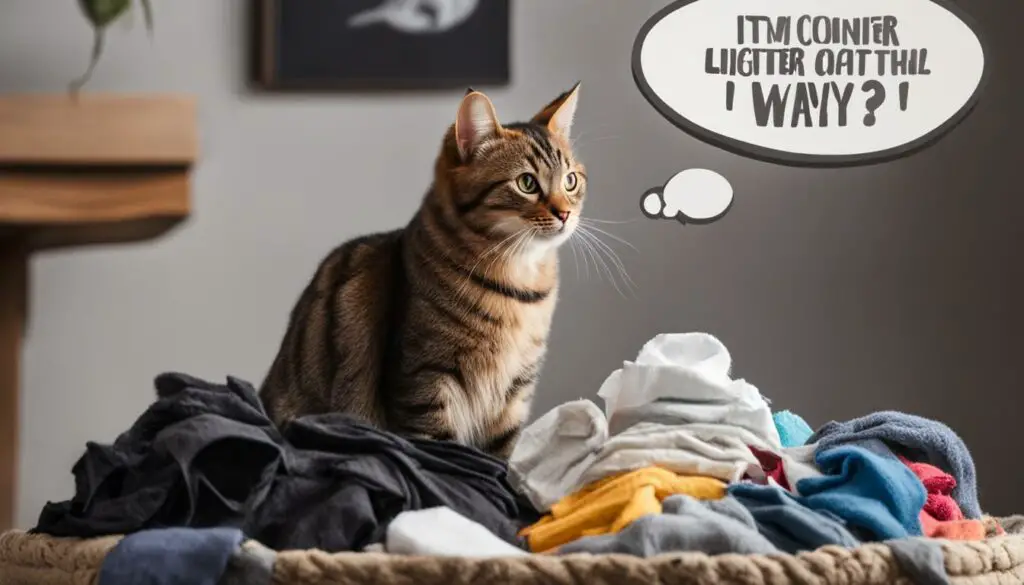
| Behavior | Message |
|---|---|
| Urinating on bags and clothes | Scent marking, asserting territorial boundaries |
| Urinating on unfamiliar objects | Territorial behavior, protecting perceived territory |
| Urinating due to stress or anxiety | Expression of distress, response to environmental changes |
Understanding your cat’s language can help you develop a deeper connection with them and address their needs effectively. By recognizing the underlying messages behind their urination behavior, such as scent marking, territorial behavior, or a response to stress, you can modify their environment and provide the necessary support to prevent inappropriate urination.
Multiple Cats in the Household
If you have multiple cats in your household, it’s important to ensure that there are enough litter boxes available for all of them. The general rule is to have one litter box per cat, plus one extra, to accommodate their individual needs. Placing the litter boxes in different locations throughout the house will also provide each cat with easy access to a litter box when needed. By providing enough litter boxes, you can prevent competition and minimize the likelihood of inappropriate urination behavior.
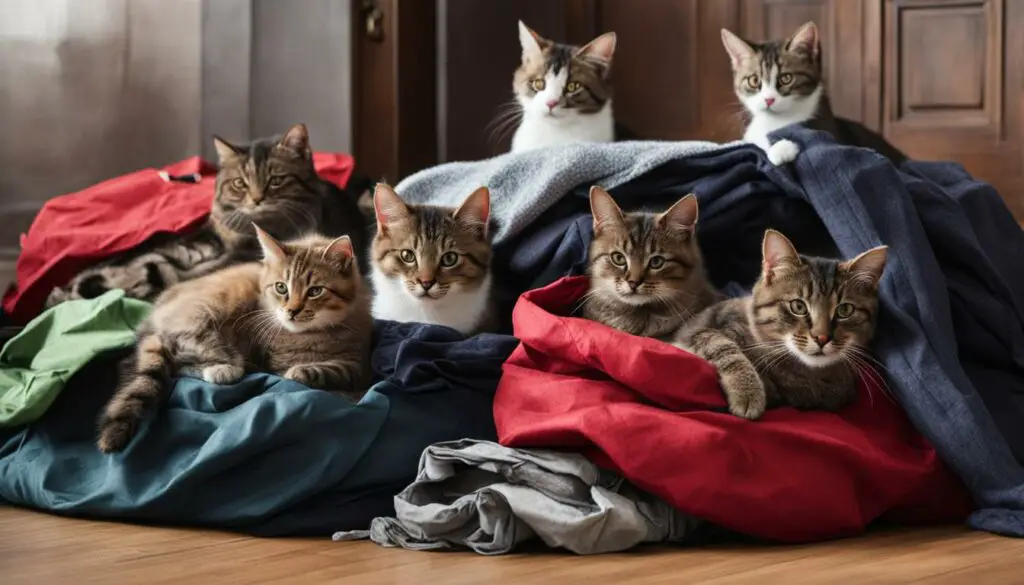
Additionally, it’s crucial to rule out any medical problems that may be affecting your cats. Inappropriate urination can sometimes be a symptom of an underlying medical condition, such as a urinary tract infection or kidney disease. If multiple cats in your household are exhibiting this behavior, it’s recommended to schedule a veterinary visit to assess their health. A thorough examination and appropriate tests can help identify and address any medical issues that may be contributing to the problem.
Remember: providing enough litter boxes and ensuring the health of your cats are key factors in preventing inappropriate urination behavior in a multi-cat household.
Dealing with Cat Spraying
In addition to peeing on bags and clothes on the floor, some cats may engage in spraying behavior, which involves marking vertical surfaces with urine. Cat spraying is a natural instinct for cats, and it can be triggered by various factors such as territorial disputes, stress, or the presence of other animals. Understanding and addressing this behavior is crucial for maintaining a clean and harmonious home environment.
Understanding Cat Spraying
Cat spraying, also known as marking behavior, is different from inappropriate urination. While urinating outside the litter box is typically a sign of a problem, spraying is a way for cats to communicate and mark their territory. By leaving their scent, cats send messages to other animals, indicating their presence and claiming their territory. It’s important to differentiate between the two behaviors in order to address them effectively.
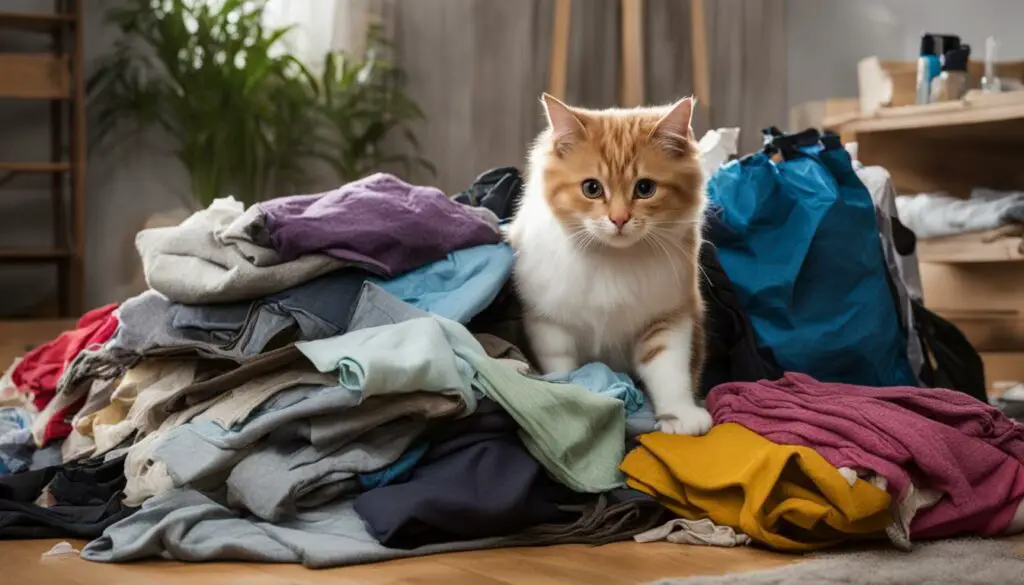
Neutralizing Odors and Using Deterrents
To tackle cat spraying, it’s essential to neutralize the odors left behind by urine. This will help prevent your cat from re-marking the same area. Use enzyme-based cleaners specifically designed for removing pet odors, as traditional cleaners may not fully eliminate the scent. Additionally, consider using deterrents in areas where your cat has sprayed, such as motion-activated devices, aluminum foil, or double-sided tape. These deterrents can help discourage your cat from engaging in spraying behavior.
Seeking Professional Help
If cat spraying persists or becomes a recurring issue, it may be necessary to seek professional help from a veterinarian or a veterinary behaviorist. These experts can assess your cat’s behavior, identify any underlying causes, and provide tailored solutions. They may recommend behavior modification techniques, medications, or environmental changes to address the spraying behavior effectively.
Maintaining a Healthy Relationship with Your Cat
Building and maintaining a healthy relationship with your cat is crucial for preventing inappropriate urination behavior. Cats thrive on attention, love, and care from their owners. By understanding their needs, attending to their behaviors, and providing a loving environment, you can strengthen your bond with your cat and reduce the likelihood of them urinating outside the litter box. Remember, cats are trying to communicate and help in their own way, and it’s our responsibility to reciprocate that love and care.
One important aspect of maintaining a healthy relationship with your cat is giving them the attention they need. Cats are social animals and require interaction and engagement from their owners. Set aside regular quality time to play with your cat, using toys that stimulate their natural hunting instincts. Engaging in interactive play not only provides physical exercise but also strengthens the bond between you and your feline companion.
Understanding your cat’s behavior is another key element in maintaining a healthy relationship. Cats communicate through various behaviors, such as body language, vocalizations, and even their urination behavior. Pay attention to any changes in your cat’s behavior, as they may be trying to convey a message. For example, excessive meowing or aggression may indicate stress or discomfort. By recognizing and addressing these behaviors, you can provide the necessary support and ensure your cat feels safe and secure in their environment.
Bonding with your cat goes beyond just providing basic care. Show your love and affection through gentle petting, soothing words, and positive reinforcement. Cats respond well to praise and rewards when they exhibit desirable behaviors. Use treats and verbal cues to reinforce good litter box habits, such as using the litter box instead of peeing on bags and clothes. By consistently praising and rewarding your cat for using the litter box appropriately, you can encourage them to continue this behavior.
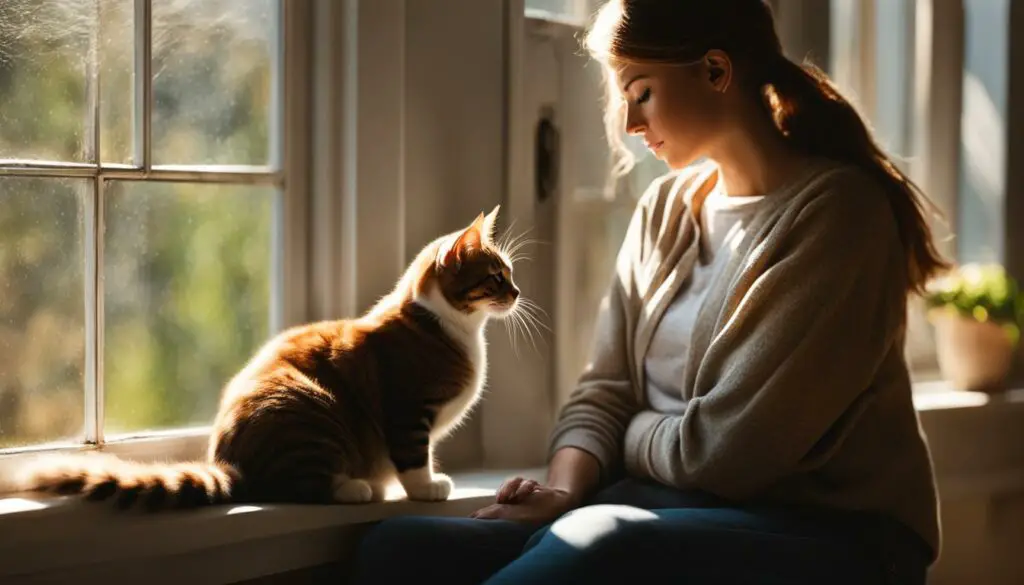
Benefits of a Healthy Relationship with Your Cat
A strong and healthy relationship with your cat not only reduces the likelihood of inappropriate urination but also has numerous other benefits. Cats that feel loved and cared for are generally happier and more content, leading to improved overall well-being. A healthy bond can also result in reduced stress levels for both the cat and the owner. Additionally, a positive relationship can enhance the cat’s trust in their owner, making them more receptive to training, behavior modification, and other interventions if needed.
Conclusion
Understanding why a cat pees on bags and clothes on the floor is crucial for finding effective solutions. By addressing both medical and behavioral causes, implementing preventative measures, and seeking professional help when needed, cat owners can successfully tackle this common issue. Patience, consistency, and love are key in resolving inappropriate urination behavior and maintaining a healthy relationship with your feline companion.
Preventative measures play a significant role in curbing this behavior. By providing a clean and accessible litter box, considering your cat’s preferences, and creating a stress-free environment, you can greatly reduce the chances of your cat peeing on bags and clothes on the floor. It’s important to remember that cats communicate through their behaviors, and addressing their needs and emotions is crucial to preventing such incidents.
When dealing with inappropriate urination, it’s essential to consider both medical and behavioral causes. Consulting with a veterinarian can help rule out any underlying medical conditions and ensure proper treatment. In some cases, seeking the expertise of a veterinary behaviorist may be necessary to develop a tailored treatment plan to address behavioral issues causing the urination problem.
Remember, cats rely on us for their well-being and happiness. Building and maintaining a healthy relationship with our feline companions through attention, love, and care is essential. By understanding their needs and responding to their behaviors, we can create a harmonious environment that minimizes the likelihood of inappropriate urination and strengthens the bond we share with our beloved cats.
FAQ
Why is my cat peeing on bags and clothes on the floor?
Cats may pee on bags and clothes on the floor due to medical conditions, behavioral issues, or problems with the litter box.
What are the medical causes of inappropriate urination?
Medical causes of inappropriate urination in cats can include urinary tract infections (UTIs), feline lower urinary tract disease (FLUTD), kidney disease, diabetes, and endocrinopathies.
What are the behavioral causes of inappropriate urination?
Behavioral causes of inappropriate urination in cats can include stress, anxiety, and territorial marking.
What are the common litter box issues that can contribute to inappropriate urination?
Common litter box issues that can contribute to inappropriate urination in cats include the location, type, size, and cleanliness of the litter box.
How can I train my cat to use the litter box consistently?
Litter box training requires finding the right litter, litter box, and litter box management routine for your cat. Consistency, accessibility, and privacy are key factors to consider.
How can I identify the underlying cause of my cat’s inappropriate urination?
A thorough examination of your cat’s medical history and a physical exam by a veterinarian, along with tests such as a urinalysis and blood tests, can help identify any medical or behavioral causes.
What preventive strategies can I implement to avoid future incidents of inappropriate urination?
Proper litter box management, stress reduction techniques, and behavioral modification techniques can be implemented to prevent further incidents of inappropriate urination.
When should I seek professional help for my cat’s inappropriate urination?
If the inappropriate urination behavior persists despite your efforts, it may be necessary to seek professional help from a veterinary behaviorist who can develop a personalized treatment plan.
How can I understand my cat’s language and address their needs?
Cats communicate through various behaviors, including urination behavior. Understanding their language can help you address their needs and prevent inappropriate urination.
How many litter boxes should I have for multiple cats in my household?
The general rule is to have one litter box per cat, plus one extra, and to place them in different locations throughout the house.
How can I deal with cat spraying?
Dealing with cat spraying may require techniques such as neutralizing odors, using deterrents, and addressing any underlying stress or territory issues.
How can I maintain a healthy relationship with my cat to prevent inappropriate urination?
Building and maintaining a healthy relationship with your cat, through attention, love, and care, is crucial for preventing inappropriate urination behavior.

